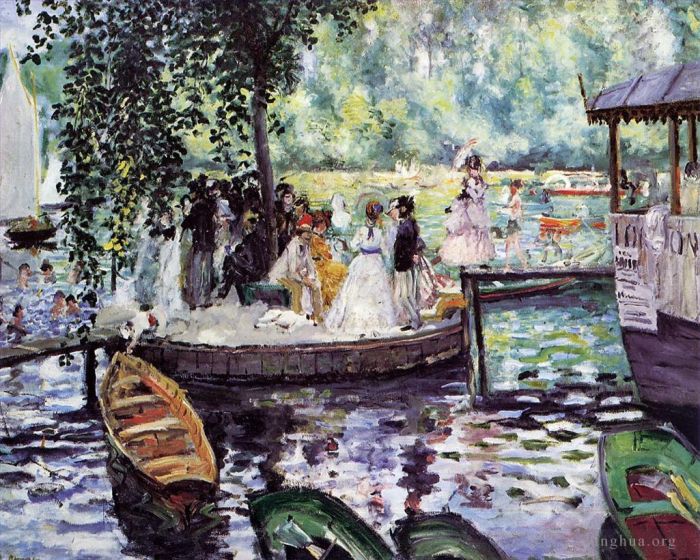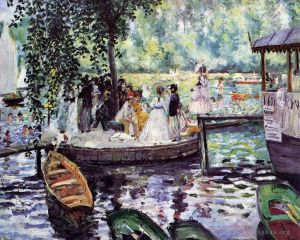La Grenouillere
Pierre-Auguste Renoir
- Price: Price on Request
- Art Type: Oil Painting
- Size:
- English Comments: 0
- International Comments: 0
- Creating Date:
- Introduction and Works of Pierre-Auguste Renoir >>
Keywords:
Grenouillere
Work Overview
- La Grenouillere
Pierre-Auguste Renoir
Date: 1869
Style: Impressionism
Period: Association with Impressionists
Genre: genre painting
Media: oil, canvas
Dimensions: 66.5 x 81 cm
Location: Nationalmuseum, Stockholm, Sweden
The Impressionists are the artists in France during the 1870s. It all really started with radical leanings among the painters, who came out in open opposition against academic conventionalism in art.
They wanted to get away from the classical insistence on an enclosed pictorial form, a varnished surface. They wanted their painterly technique to be open-ended, and they refused to delimit their subjects in the accepted way. This approach eventually caught on everywhere in western art, and it has left its imprint on the paintings of the 1870s and 1880s.
Auguste Renoir's La Grenouillère, the frog pond, has all these ingredients - a sketch-like painting, which to contemporaries seemed unfinished, no carved-out details, a glitter of sun reflecting the movements of the water, the boats partly truncated to convey a sense of the passing moment, and the individual details toned down in favour of the overall picture. But, the depiction of reality is still there.
Renoir has depicted an actual moment and life as it is lived, a fragment without any greater depth of interpretation. The theme is a new one: instead of something heroic, we have a casual, trivial excerpt from reality, held together by the lighting.
At the popular outdoor bathing spot and bar La Grenouillère ("The Frog Pond"), Renoir and Monet, not yet financially successful artists, painted images of middle-class leisure that they hoped to sell to its wealthy clientele. As they worked closely alongside one another, the two simultaneously developed several of the theories, techniques, and practices that would give rise to Impressionism. Both artists painted this scene from this exact vantage point. If Monet's gives a broader perspective and focuses more on the vivid effects of light on the water and surrounding trees, then Renoir's version gives a closer view of the fashionable denizens of the popular resort. Indeed, even when painting nature en plein air, Renoir gave a weight to the human subject perhaps unmatched by his fellow Impressionists.
- Copyright Statement:
All the reproduction of any forms about this work unauthorized by Singing Palette including images, texts and so on will be deemed to be violating the Copyright Laws.
To cite this webpage, please link back here.
- >> English Comments
- >> Chinese Comments
- >> French Comments
- >> German Comments
- >>Report
- Woman with a cat
- Irene cahen danvers
- Girl with a basket of fish
- Portrait of ambroise vollard
- The umbrellas
- The artists family
- Champs elysees paris fair
- A Girl with a Watering Can
- Bouquet of roses flower
- At the concert
- Gabrielle with bare breasts
- The gust of wind
- Mixed Spring Flowers
- Riding in the bois de boulogne
- Woman with a parasol
- Place clichy
- Young girl with a parasol
- Henry Onions still life
- Apres le bain
- Nude in the sunlight
- Girl streched out on the grass
- Daughters of catulle mendes
- The Grands Boulevards
- Jeanne samary 1878
- Woman gathering flowers
- Dance at Le moulin de la Galette
- Study Summer
- Dance at Bougival
- Young woman with a japanese umbrella
- The washer women
- The Bathers
- Young spanish woman with a guitar
- At The Theatre
- Aline and pierre
- Lanscape in la roche guyon
- Banks of the seine at champrosay
- The vintagers
- Leaving The Conservatoire
- Self portrait
- Gabrielle and jean
- Study Torso Sunlight Effect
- Reclining nude 1890
- The farm
- Monet painting in his garden at Argenteuil
- Jeanne durand ruel
- Mother anthonys inn at marlotte
- Parisiennes in algerian dress
- August madame 1872
- Madame monet lying on sofa
- La Promenade
- Luncheon of the Boating Party
- Roses in front of a blue curtain flower
- Landscape at vetheuil
- Vase of Chrysanthemums
- Gypsy girl
- Still life with flowers
- Three bathers
- The blue river
- Apples and Flowers
- Woman tying her shoelace
- Odalisque (An Algerian Woman)
- The Doges Palace
- Charles and georges durand ruel
- Woman standing by a tree
- Young girl reading
- The Dancer
- Claude Monet Reading (Reading A Newspaper)
- Girl with a Straw Hat (Young Girl in a Straw Hat)
- Portrait of richard wagner
- View of Venice Fog
- Landscape between storms
- Woman playing the guitar
- The laundress
- A box in the theater des varietes
- Fruits from the Midi
- Claude playing
- Madame charpentier
- Young woman seated
- Young Girls at the Piano
- Portrait Of The Actress Jeanne Samary
- Julie manet
- Romaine Lascaux
- Lady in a white hat
- Still Life With Bouquet
- Madame henriot
- The first step
- Terraces at Cagnes
- Gabrielle in a red blouse
- Lady with a veil
- Monsieur fournaise
- Alphonsine fournaise
- Two Girls Reading
- Landscape at cagnes
- Bouquet in front of a Mirror
- Portrait of Alfred and Marie Sisley
- Casbah
- Blonde Bather
- Girl with a basket of oranges
- The Apple Seller
- House in collett at cagnes
- After the bath
- Madame Monet and Her Son
- Railway bridge at chatou
- Path Leading through Tall Grass
- Nude on cushions
- Oarsmen at chatou
- Woman combing her hair
- Jeanne Samary in a Low Necked Dress
- Girl With A fan
- Rocky craigs at lestaque
- Portrait of alfred sisley
- Andree in blue
- Woman reading
- Maison de la poste cagnes
- Enoir picking flowers
- Gabrielle with jean and little
- Washerwomen
- La Grenouilliere
- Summer hats
- A Bather (Bather is Styling)
- Pensive
- Young woman with a dog
- Head Of A Woman
- Young woman wearing a hat with wild roses
- The Large Bathers
- Portrait of jeanne samary
- In the Meadow
- The pont neuf paris
- Marie murer
- Portrait of jean frederic bazille
- Therese berard
- Mother and children
- Strawberries
- The Seine at Asnieres (The Skiff)
- Jugglers at the cirque fernando
- Woman by a fence
- Laundresses
- The Theatre Box (La Loge)
- Flowers in a vase 1866
- Portrait of coco
- Bather with Blonde Hair
- The spring
- The canoeists luncheon
- Woman in a park
- Gabrielle with a rose
- The luncheon
- Dance in the Country
- Yvonne and christine lerolle playing the piano
- The artists son jean
- Mosque in algiers
- Woman In Black
- Sailboats at argenteuil
- Lise with an Umbrella
- Piazza san marco venice
- The parisian
- Young boy with a cat
- Portrait of a girl
- By the seashore
- La mere aux oies
- Torso Before the Bath The Toilette
- Sleeping bather
- Woman at the piano
- Girl wiping her feet
- Georges riviere
- Landscape
- Bathers 1910
- Garden in rue cortot montmartre
- Bather on a rock
- Sleeping girl with a cat
- Portrait of madame chocquet
- Portrait actress jeanne samary
- The first outing
- Nini in the garden
- A girl with a watering can Pierre Auguste Renoir
- Bather with Long Hair
- Portrait of claude monet
- Girl with a hoop
- Young girl combing her hair
- Madame and bob
- Fisherman on riverbank
- Andree in yellow turban and blue skirt
- Claude monet
- The swing
- Child With A Whip
- Regatta at argenteuil
- Anemones flower
- Peaches on a plate still life
- 5 la promenade
- Mixed Flowers In An Earthenware Pot
- Mlle charlotte berthier
- The horsewoman
- Seated Bather
- Mother and child (Motherhood or Woman Breast Feeding Her Child)
- Woman at the fountain
- Young shepherd in repose
- Diana
- Mademoiselle sicot
- The Rambler
- View of antibes
- Portrait of victor chocquet 75
- Roses and jasmine in a delft vase flower
- After the luncheon
- Jules le couer in fontainebleau forest
- Bathers
- Young woman wearing a hat
- Yvonne and jean
- Beach scene guernsey
- Woman with a mandolin
- The bather
- Dance in the City (City Dance)
- Madame charpentier and her children
- The coiffure
- Skaters in the Bois de Boulogne
- Bather Arranging her Hair
- Still life with peaches and grapes
- Claude monet reading
- Head of a dog
- Madame Renoir with a Dog
- Portrait of william sisley
- The garden in montmartre
- Madame Georges Charpentier and her Children
- At the Luxembourg Gardens
- La Grenouillere
- Young women talking
- The Pont des Arts, Paris (The Pont des Arts and the Institut de France)
- Bouquet of spring flowers
- Bernheim de villers
- Two Sisters (On the Terrace)
- The meadow
- Child in white
- Tilla durieux
- Young woman braiding her hair









 Singing Palette
Singing Palette